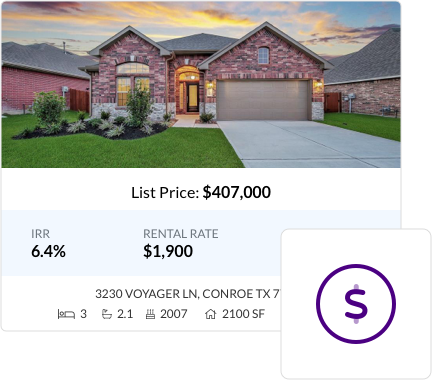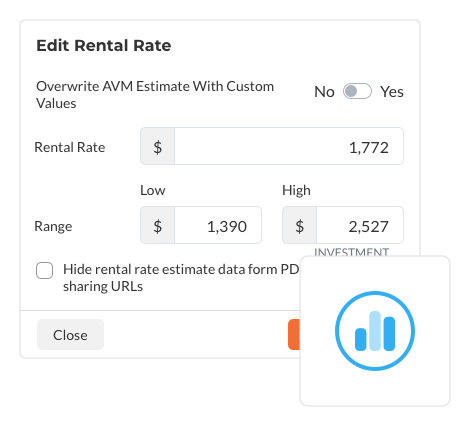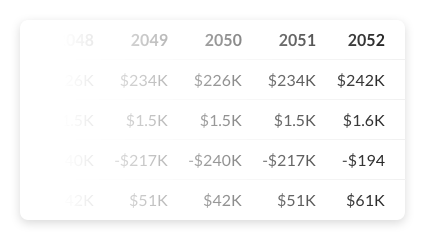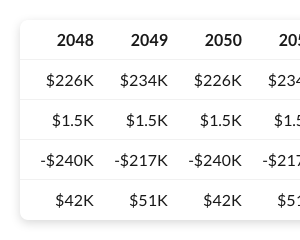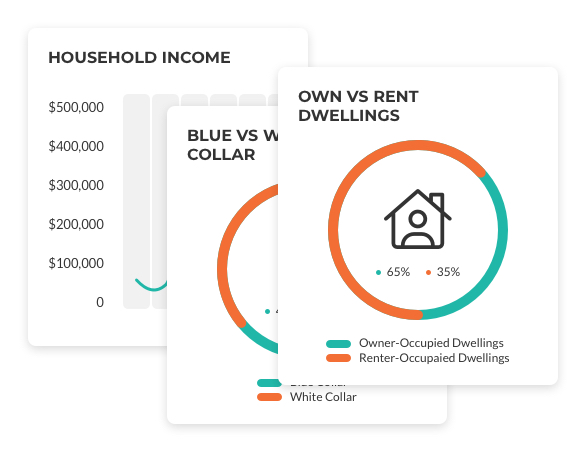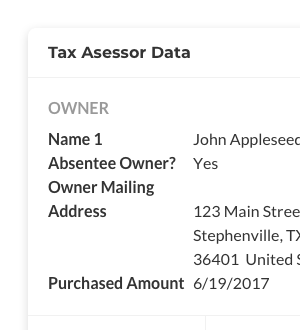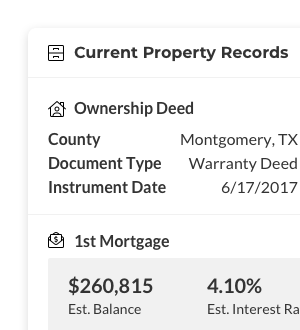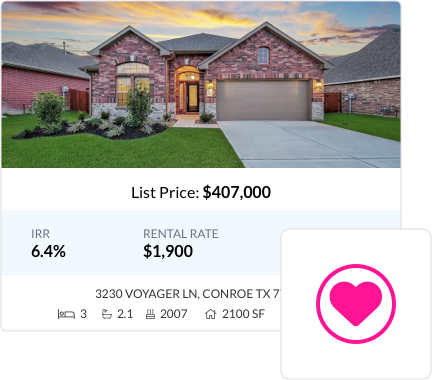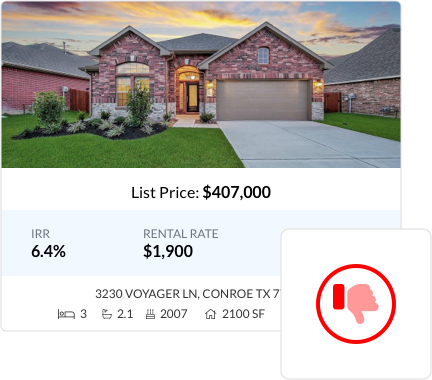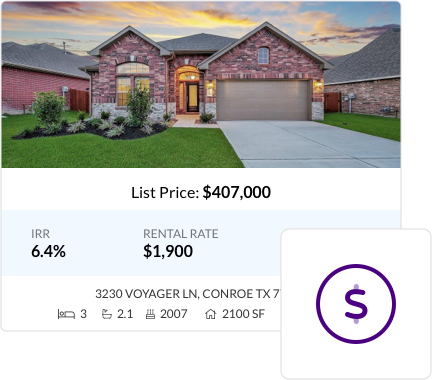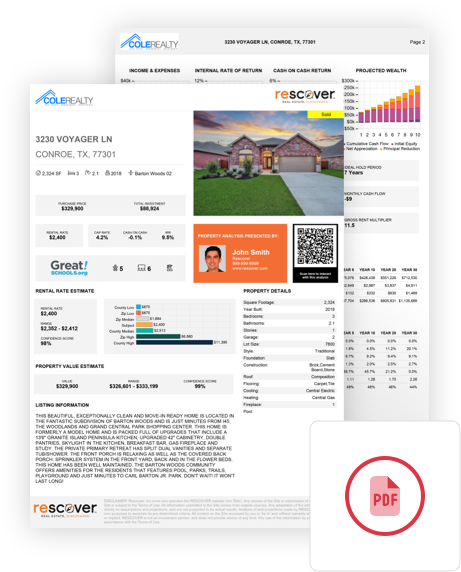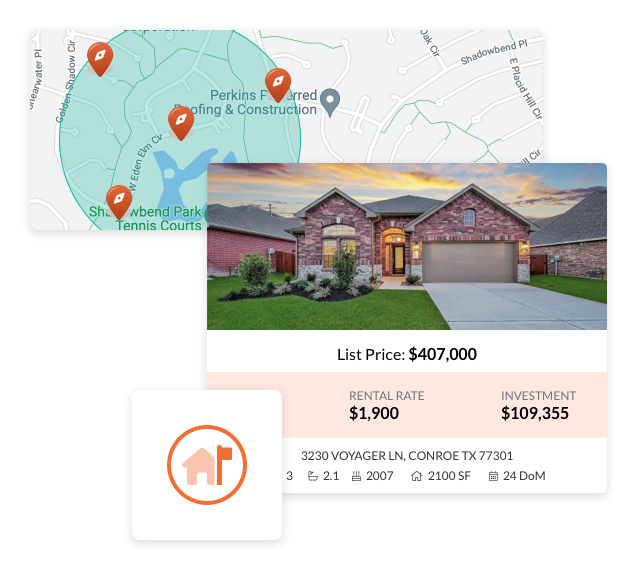
20122 E MESA VERDE RD
-
Rental Rate$0
Purchase PriceCash on Cash (CoC) Return is the amount of cash flow you receive in one year compared to the amount of cash invested.
Your Cash on Cash gauge reflects a goal of . You can adjust your CoC goal in Settings - Blue Chip Criteria.
The formula for Cash on Cash Return is:
Using the value from the analysis on this page, the CoC Return is calculated as follows:
Continue to learn more!:
Rescover Investment Term Library
Internal Rate of Return (IRR) measures how much, on average, you earn annually from a property—factoring in both the amount of money you invest and when you get money back (like rental income or sale proceeds).
Your IRR gauge reflects an IRR goal of . You can adjust your IRR goal in Settings - Blue Chip Criteria.
While cap rate and cash on cash measure the value and performance of a property annually, IRR takes into consideration appreciation, amortization, and the time value of money.
Because earlier cash flow is "worth more" in IRR terms, a faster exit can increase IRR even if you end up with less total profit. That's why it's helpful to look at both IRR and total wealth accumulation when deciding how long to hold the property.
The formula for IRR is quite complex. It is not something you would ordinarily calculator without a financial calculator or spreadsheet.
To setup an IRR calculation, you need to know your initial investment, the cash flows received each year during the investment, and the sales proceeds at disposition. This information is placed in a t-bar chart, in the format below:
| Period | Cash Flow | + | Sales Proceeds |
|---|---|---|---|
| 0 | (Initial Investment) | ||
| 1 | CF 1 | ||
| CF x | |||
| 7 | CF 7 | + | Sales Proceeds |
A t-bar chart populated with the values from the property analysis on this page looks as follows:
| EoY | Cash Flows | Sale Proceeds |
|---|
IRR = 0.0%
Adjust the hold period below to see how it affects the IRR
Continue to learn more!:
Rescover Investment Term Library
-
Initial InvestmentInitial Investment is the total amount of money you put in upfront to purchase and prepare the property—like your down payment, closing costs, and any immediate repairs or improvements. This figure helps you see how much of your own cash is tied up before rental income (or other revenue) starts coming in.
The initial investment for the property on this page is summarized in the table below:
Calculating
| Purchase Price | |
| Plus: Title Charges | |
| Plus: Rehab Expense | $0 |
| Total Cost | $0 |
|---|---|
| Less: Loan Amount | () |
| Plus: Loan Fees | |
| Plus: Working Capital | $0 |
| Initial Investment | - |
Automated Valuation Modeling (AVM) uses machine learning algorithms to predict the rental rate for the subject property. These values are updated as often as monthly, based on closed transactions of similar properties in the area. Adjustments to the rental rate in the Rescover calculator will not affect the figures displayed on this card.
Calculating
Annual Cash Flow
This chart shows how much profit or loss you generate each year after paying all property expenses, including mortgage. It helps you visualize whether or not the property is self-sustaining and the inflection point for when it is expected to become cash flow positive.
Return on Investment
This graph compares two ways to measure your annual return:
- Cash on Cash: How much income you earn relative to your original cash invested (down payment, closing costs, etc.).
- Return on Equity: How much income you earn based on your current equity (the portion of the property you actually own).
Watching both lines helps you decide if it's time to sell, refinance, or keep building equity.
- Cash on Cash
- Return on Equity
IRR & Net Gain
Here we see:
- Internal Rate of Return (IRR): An annualized percentage that factors in when you receive cash flows and the sale proceeds.
- Net Gain: The total dollar profit after subtracting your initial investment.
A higher IRR often signals a more profitable or faster-paying investment, while Net Gain shows the overall profit you walk away with.
A higher IRR often signals a more profitable or faster-paying investment, while Net Gain shows your overall bottom line. However, IRR can peak early. If your IRR still beats other investment options, holding a property longer—even if the IRR seems stagnant—may increase your Net Gain in the end. Decide when you’re satisfied with your total profit before selling, especially if good investment properties are hard to find.
- Internal Rate of Return
- Net Gain

Create an account
to view KPIs!
Calculating
| Purchase Price | |
| Plus: Title Charges | |
| Plus: Rehab Expense | $0 |
| Total Cost | $0 |
|---|---|
| Less: Loan Amount | () |
| Plus: Loan Fees | |
| Plus: Working Capital | $0 |
| Initial Investment | - |
Calculating
| Mortgage Payment (P&I) | |
| Property Tax | |
| Property Insurance | |
| Total Monthly Costs |
|---|
Calculating
Calculating
| INCOME |
|---|
| Gross Potential Income |
| Vacancy Loss |
| Effective Rental Income |
| OPERATING EXPENSES |
| Property Tax |
| Property Insurance |
| HOA |
| Property Management |
| Leasing Commissions |
| Property Maintenance |
| Utility Expenses |
| Other Expenses |
| Total Expenses |
| Net Operating Income |
| NON OPERATING EXPENSES |
| Annual Debt Service |
| Capital Expenditures |
| Total Non Operating Expenses |
| Total Cash Flow |
Calculating
| Property Value The property value displayed in this table shows the expected appreciation you will realize over the next 30 years. |
|---|
| Rental Rate The rental rate displayed in this table shows the expected future rental rates you will achieve over the next 30 years. |
| Monthly Cash Flow Monthly cash flow is the average amount expected to receive each month after operating expenses and debt service are paid. |
| Gross Wealth Accumulation Gross Wealth Accumulation is the amount you would expect to receive at the end of each year, including cumulative cash flow, and the gross proceeds at the sale of the home. |
| Net Gain on Investment Net Gain on Investment is the total profit (or loss) you see after accounting for every dollar spent—like the purchase price, repairs, and other costs—and every dollar earned from rental income or a future sale. Essentially, it answers, "How much did I actually make from this property when all’s said and done?" |
Calculating
| Cap Rate Capitalization Rate, or Cap Rate for short, is the rate which your capital is returned after the first year. Your Cap Rate gauge reflects a goal of . You can adjust your Cap Rate goal in Settings - Blue Chip Criteria. The formula for cap rate is: Net Operating IncomeTotal Cost = Cap Rate % Using the value from the analysis on this page, the Cap rate is calculated as follows: = When used in conjunction with NOI, cap rate can also be used to determine a property's value. The formula to determine property value based on a known cap rate is as follows: NOI Cap Rate = Property Value Using the NOI of the property on this page, and an cap rate, the market value is calculated as follows: = Continue to learn more!: | |||||||||||||||||||||||
|---|---|---|---|---|---|---|---|---|---|---|---|---|---|---|---|---|---|---|---|---|---|---|---|
| CoC Cash on Cash (CoC) Return is the amount of cash flow you receive in one year compared to the amount of cash invested. Your Cash on Cash gauge reflects a goal of . You can adjust your CoC goal in Settings - Blue Chip Criteria. The formula for Cash on Cash Return is: Annual Cash FlowTotal Investment = CoC % Using the value from the analysis on this page, the CoC Return is calculated as follows: -- = - Continue to learn more!: | |||||||||||||||||||||||
| IRR Internal Rate of Return (IRR) measures how much, on average, you earn annually from a property—factoring in both the amount of money you invest and when you get money back (like rental income or sale proceeds). Your IRR gauge reflects an IRR goal of . You can adjust your IRR goal in Settings - Blue Chip Criteria. While cap rate and cash on cash measure the value and performance of a property annually, IRR takes into consideration appreciation, amortization, and the time value of money. Because earlier cash flow is "worth more" in IRR terms, a faster exit can increase IRR even if you end up with less total profit. That's why it's helpful to look at both IRR and total wealth accumulation when deciding how long to hold the property. The formula for IRR is quite complex. It is not something you would ordinarily calculator without a financial calculator or spreadsheet. To setup an IRR calculation, you need to know your initial investment, the cash flows received each year during the investment, and the sales proceeds at disposition. This information is placed in a t-bar chart, in the format below:
A t-bar chart populated with the values from the property analysis on this page looks as follows:
IRR = 0.0% Adjust the hold period below to see how it affects the IRR Continue to learn more!: | |||||||||||||||||||||||
| RoE Return on Equity (RoE) measures how effectively the property’s equity—what you actually own after subtracting any loans—is working to generate profit. In simpler terms, it’s how much money you earn (net profit) each year for every dollar of your own equity in the property. As you pay down the mortgage and the property potentially appreciates, your equity grows, and tracking RoE can help you decide whether to keep, refinance, or sell. | |||||||||||||||||||||||
| LTV Loan to Value (LTV) compares how much you owe on the property (your loan balance) to its market value. For example, if you borrow $80,000 on a $100,000 home, your LTV is 80%. As you pay down your mortgage (amortization) and the property’s value changes, your LTV adjusts each year—giving you insight into how quickly you’re building equity or reaching a target LTV for refinancing. | |||||||||||||||||||||||
| Debt Coverage Ratio Debt Coverage Ratio (DCR) shows how easily the property’s income can cover its mortgage each month. It’s calculated by taking the property’s net operating income and comparing it to the total debt payments. A DCR above 1.0 indicates you’re earning enough to pay the loan, while a higher ratio (e.g., 1.2) means you have a cushion for unexpected costs. Lenders often look at DCR to decide whether the property is a safe investment. | |||||||||||||||||||||||
| OPEX Ratio Operating Expense Ratio (OPEX ratio) shows what fraction of your rental income is spent on property-related costs—like maintenance, utilities, insurance, and property taxes. It’s calculated by dividing your total operating expenses by the property’s income. A lower OPEX ratio typically means you’re keeping expenses under control and retaining more profit. |
Calculating
| INCOME | ||||||||||||||||||||||||||||||
|---|---|---|---|---|---|---|---|---|---|---|---|---|---|---|---|---|---|---|---|---|---|---|---|---|---|---|---|---|---|---|
| Potential Rental Income | ||||||||||||||||||||||||||||||
| Less: Vacancy Loss | ||||||||||||||||||||||||||||||
| Effective Income | ||||||||||||||||||||||||||||||
| OPERATING EXPENSES | ||||||||||||||||||||||||||||||
| Property Tax | ||||||||||||||||||||||||||||||
| Property Insurance | ||||||||||||||||||||||||||||||
| HOA | ||||||||||||||||||||||||||||||
| Property Management | ||||||||||||||||||||||||||||||
| Property Maintenance | ||||||||||||||||||||||||||||||
| Utility Expenses | ||||||||||||||||||||||||||||||
| Other Expenses | ||||||||||||||||||||||||||||||
| Total Expenses | ||||||||||||||||||||||||||||||
| Net Operating Income | ||||||||||||||||||||||||||||||
| NON OPERATING EXPENSES | ||||||||||||||||||||||||||||||
| Annual Debt Service | ||||||||||||||||||||||||||||||
| Capital Expenditures | ||||||||||||||||||||||||||||||
| Total Non Operating Expenses | ||||||||||||||||||||||||||||||
| Total Cash Flow | ||||||||||||||||||||||||||||||
View our full 30 year analysis
with an account!
Calculating
| Capital Invested (Beginning of Year) |
|---|
| Refi Cash In/Out |
| Capital In/Out |
| Capital Invested (End of Year) |
Calculating
| Property Value |
|---|
| Loan Balance |
| Cost of Sale |
| Net Equity |
Calculating
| Net Equity |
|---|
| Cummulative Cash Flow |
| Gross Wealth Accumulation |
| Net Investment |
| Net Gain on Investment |
 School Information
School Information

View detailed school information
with an account!
Learn more about school information
Offcanvas with body scrolling
